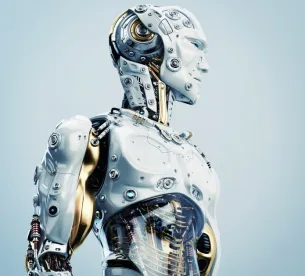In our Feb. 9th post, we highlighted some of the amazing technology being used at the 2018 Winter Olympics in Pyeongchang, South Korea. While awe-inspiring, the use of these technologies can give rise to legal challenges that may need consideration.
AI, Robots and Drones – Oh My!
Artificial intelligence (AI) abounds at this year’s Winter Olympics, particularly in the form of robots and drones. South Korea has one of the highest concentrations of industrial robots in the world, so it’s no surprise that this Olympic host country is using 85 very different AI-enabled robots to do everything from greeting travelers and providing multilingual information on schedules, transport, and attractions, to carrying the Olympic torch. As part of the entertainment at the games, robots even competed in their own Olympic ski challenge this week. Drones are also taking center stage with elaborate light shows and filming techniques.
Despite having significant potential, the use of AI-enabled robots and drones, as with any disruptive technology, can lead to a number of legal and regulatory issues that impact this emerging sector, from manufacturers to users. Here are just a few legal issues to consider:
-
Standards: One cannot regulate something without first defining it. However, the term “robot” is technical and encompasses a wide range of applications. For this very reason, it can be difficult to develop standards that are applicable to different robotic applications.
-
Causation: AI-powered devices are increasingly making decisions absent of any direct programming but rather based on machine learning principles. As a result, it becomes harder to attribute the question of fault, and causation becomes problematic to determine.
-
Liability: If an accident involves AI, it is challenging to identify the liable party. For example, what happens when an autonomous car and bus collide, or when a smart car hits a pedestrian? Who is the liable party? The programmer who developed the source code or the lab that tested the vehicle’s protocols, or maybe the car owner?
-
Humanizing robots: As AI gets closer to actual consciousness, will robots be granted certain rights and legal responsibilities? If AI commits a crime, can the software itself be held liable? Switzerland faced that very problem when a robot bought illicit substances online.
-
Regulatory compliance: Regulators around the world are grappling with how to address AI. On the drone front, the U.S. Federal Aviation Administration (FAA), which is part of the US Department of Transportation, monitors drone usage at the federal level. Today, there is wide variation in legislation across U.S. states, as the government at all levels looks to define what a drone is, who can and cannot operate them, and how and where they can be used, as well as where they cannot be used.
-
Intellectual property (IP) protection: The surge in AI innovation and application requires that innovators quickly develop IP strategies to protect and monetize their technologies.
-
Product liability: As with any product used in the domestic market, product liability considerations apply to the design, manufacture, sale, and operation of robots and drones. Product liability has the potential to be a significant risk exposure for the AI industry.
-
Privacy: AI already tracks and predicts individuals’ shopping preferences and locations, among other things. The data accumulated and shared between these technologies has created many legal controversies regarding privacy.
-
Cybersecurity: Robots and drones are exposed to cyberattack. As their applications continue to expand, they could increasingly become a target for cyber thieves and hackers. In fact, Olympic officials confirmed that a cyberattack took place during the opening ceremonies in Pyeongchang, according to Reuters. The organizers say that while television and internet access was affected, “it had not compromised any critical part of their operations.”
Beyond the Olympics: a legal and regulatory tangle
When it comes to AI-enabled robots and drones, there currently can be more legal questions than answers. With a wide range of applications, we have yet to see the full potential of these AI-enabled machines. Manufacturers, regulators, and users will need to work together to ensure this technology is used safely and responsibly.



 />i
/>i

